Click on images to enlarge

infestation (Photo: Sheldon Navie)

habit (Photo: Sheldon Navie)

older stems that spread by layering (Photo: Sheldon Navie)

hairless younger stem and long leaf stalks (Photo: Sheldon Navie)

palmately-lobed leaf (Photo: Sheldon Navie)
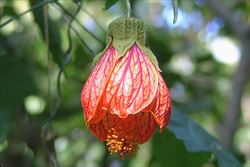
drooping flower with reddish veins on its orange petals (Photo: Sheldon Navie)

close-up of flower showing numerous stamens (Photo: Sheldon Navie)

close-up of immature fruit (Photo: Sheldon Navie)
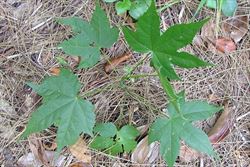
young plant (Photo: Sheldon Navie)
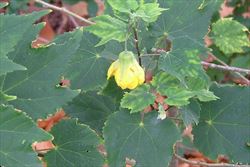
Chinese lantern (Abutilon x hybridum) cultivar (Photo: Sheldon Navie)

close-up of flower of a Chinese lantern (Abutilon x hybridum) cultivar (Photo: Sheldon Navie)
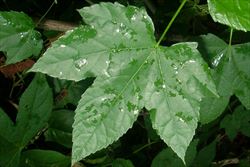
leaf with five pointed lobes (Photo: Sheldon Navie)
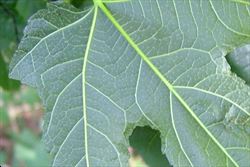
close-up of leaf underside, showing the sparse covering of tiny star-shaped hairs (Photo: Sheldon Navie)

close-up of immature fruit showing its covering of brownish coloured star-shaped hairs (Photo: Rob Whyte)

mature fruit (Photo: Sheldon Navie)
Scientific Name
Abutilon pictum (Gill. ex Hook. & Arn.) Walp.
Synonyms
Abutilon striatum Dicks. ex Lindl.Sida picta Gill.
Family
Malvaceae
Common Names
abutilon, Chinese lantern, flowering maple, Indian mallow, orange lantern, painted Indian mallow, parlor maple, parlour maple, redvein Indian mallow
Origin
Native to South America (i.e. southern Brazil, Ecuador, Peru, Paraguay, Uruguay and northern Argentina).
Naturalised Distribution
This species has recently become naturalised near Melbourne in southern Victoria, near Sydney in the coastal districts of central New South Wales, and in Brisbane in south-eastern Queensland.
Notes
Flowering maple (Abutilon pictum) is widely cultivated as a garden ornamental, and there are numerous cultivars and hybrids of this species available in Australia. The most common and well known of these is spotted flowering maple (Abutilon pictum 'Thompsonii'), which has golden-spotted leaves that are caused by a virus infection.
This species has begun to escape cultivation in recent years and is an emerging or potential environmental weed in Queensland, New South Wales and Victoria. It spreads by seed and also vegetatively by layering, eventually forming very large and dense colonies. Flowering maple (Abutilon pictum ) was first recorded becoming naturalised in Victoria, shortly after the turn of the century. It was then reported to be spreading from plantings and naturalising along a creek at Glenbrook, in the lower Blue Mountains, in 2003. At this location, a dense colony of hundreds of upright stems was present in a relatively small area.
Even more recently, in late 2006, a larger population was recorded along Enoggera Creek in The Gap in Brisbane. This infestation had formed almost a monoculture in the understorey of the riparian vegetation at this site. It probably resulted from the dumping of garden waste and consisted of dozens of large plants, up to 2 m or more tall, over an area of a couple of hundred of square metres. The almost simultaneous new records from three states, and the dense colony-forming habit of this species, indicate that flowering maple (Abutilon pictum ) may have the potential to become a serious environmental weed in riparian habitats in the coastal districts of eastern Australia.
Note: Chinese lantern (Abutilon x hybridum) has also recently been recorded as becoming naturalised in south-eastern and northern Queensland. Numerous cultivars of this plant can also be found in cultivation and are thought to be derived from horticultural crosses of several species, but principally Abutilon pictum and Abutilon darwinii.

